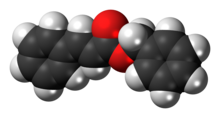Benzyl cinnamate
 |
|
 |
|
| Names | |
|---|---|
|
IUPAC name
Benzyl 3-phenylprop-2-enoate
|
|
| Other names
Benzylcinnamate; Cinnamein; Benzylcinnamoate; Benzyl 3-phenylpropenoate; 3-phenyl-2-propenoic acid phenylmethyl ester; Cinnamic acid benzyl ester
|
|
| Identifiers | |
| 103-41-3 | |
| 3D model (Jmol) | Interactive image |
| ChemSpider | 4437893 |
| ECHA InfoCard | 100.002.827 |
| PubChem | 5273469 |
|
|
|
|
| Properties | |
| C16H14O2 | |
| Molar mass | 238.29 g·mol−1 |
| Appearance | White to pale yellow solid |
| Melting point | 34 to 37 °C (93 to 99 °F; 307 to 310 K) |
| Boiling point | 195 to 200 °C (383 to 392 °F; 468 to 473 K) 5 mmHg |
| Insoluble | |
| Solubility in ethanol | 125 g/L |
| Solubility in glycerin | insoluble |
| Solubility in propylene glycol | insoluble |
|
Except where otherwise noted, data are given for materials in their standard state (at 25 °C [77 °F], 100 kPa).
|
|
| Infobox references | |
Benzyl cinnamate is the chemical compound which is the ester derived from cinnamic acid and benzyl alcohol.
Benzyl cinnamate occurs in Balsam of Peru and Tolu balsam, in Sumatra and Penang benzoin, and as the main constituent of copaiba balsam.
Benzyl cinnamate can be prepared by heating benzyl chloride and excess sodium cinnamate in water to 100-115 °C or by heating sodium cinnamate with an excess of benzyl chloride in the presence of diethylamine.
Benzyl cinnamate is used in heavy oriental perfumes and as a fixative. It is used as a flavoring agent.
...
Wikipedia
